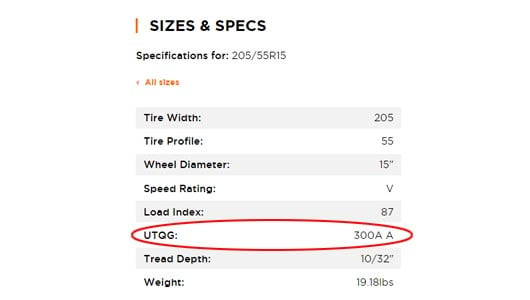What are UTQG ratings?

When you’re shopping for tires online, you might come across this acronym: UTQG. It stands for Uniform Tire Quality Grade, but what does that mean, and what do you need to know about UTQG ratings?
What is a UTQG rating?
The UTQG rating system was created to help drivers make more informed tire-buying decisions. Tire manufacturers give their own tires a grade for:
- Treadwear
- Traction
- Temperature
Together, these numbers make up a tire’s UTQG rating—a three-digit number plus two letters, such as 300 AA.

You can also inspect your current tires’ UTQG rating by inspecting the sidewall near the tire size.

Manufacturers arrive at these numbers by comparing a tire’s performance results to the results of a standard control tire.
What does each of the UTQG really tell you about the quality of your tires? Here’s a breakdown.
What is a treadwear rating?
The treadwear grade is designed to give you a picture of the durability or life you can expect from your tire. What you need to know about the treadwear grade is this: The higher the treadwear number, the longer it’ll take the tread to wear down. Higher is better.
The control tire has a treadwear grade of 100. So, if the tire being tested gets a 200 treadwear rating, that means it’s expected to take twice as long to wear out as the control tire.
To get a treadwear grade, tires run a 640-kilometre course for 11,520 km, with tread depths being measured every 1,280 to give a projected tread life.
What is a traction tire rating?
A traction grade tells you how well your tire can stop in wet conditions. The highest traction grade is AA, followed by A, B, and C. Tires with an ‘AA’ traction rating should stop at a much shorter distance than a tire with a ‘C’ rating.
What does temperature mean on a tire?
"Temperature" is a heat resistance rating. Tires are always up against the stress of heat that can build up driving at high speeds and/or in warm weather. If a tire gets too hot, blowouts can result.
The temperature rating tells you how well a tire is able to resist heat build-up. Tires are graded with an A, B, or C, with ‘A’ being the highest, most heat resistant and ‘C’ being the lowest, least heat resistant. In other words, an A-rated tire can withstand higher temperatures than a C-rated tire.
While understanding UTQG can help you make more informed decisions when you’re comparing summer, all-season, winter or all-weather tires, remember that the grades are given by manufacturers, so they can be subjective.
For unbiased tire testing results conducted by third-party professionals in everyday Canadian driving conditions, view the Kal’s Tire Testing results for the tires you’re interested in.





